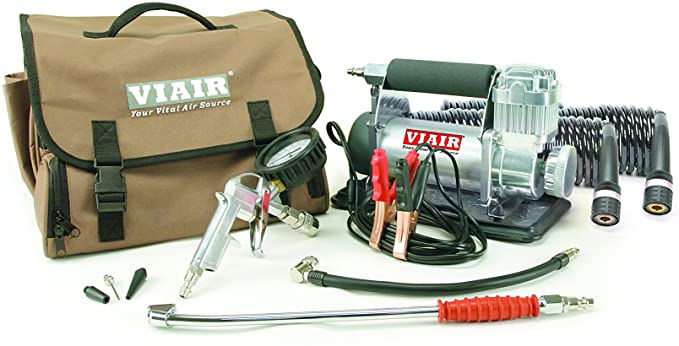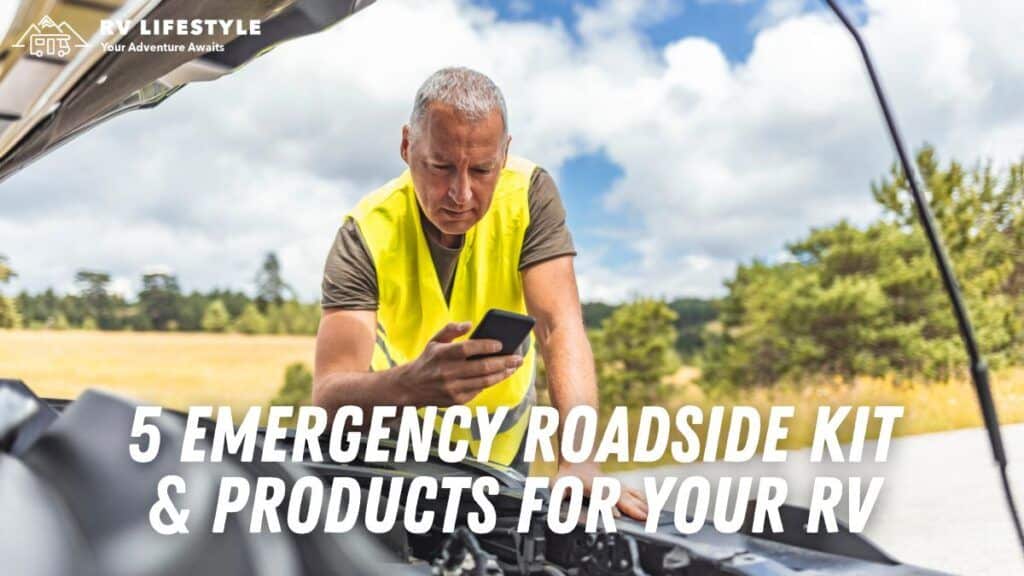Correct tire stress is critically essential not solely to your security however the lifetime of your tires. Right here is why you must test RV tire stress EVERY journey day…
RV tires are important to a protected, easy journey, but they’re usually probably the most neglected components of an RV. Individuals know they should test them, however they don’t understand how usually they need to test them.
RVers ought to give a visible inspection of their tires earlier than each journey day. However that’s not all! It might appear tedious, however you must also test your RV tire stress earlier than you hit the highway… each time!
Isn’t that overkill, Mike?! It’s actually not, and I’ll inform you why. (Spoiler alert: it’ll prevent time, cash, and complications!)
For those who purchase one thing via our hyperlinks, we could get a small fee at no additional value to you. It helps hold our lights on so we will proceed to supply useful assets for RVers. Learn our full affiliate disclosure right here.
RV Tires: What You Must Know
Like what you see in these movies? We might admire it should you would Subscribe to our YouTube Channel (simple to do proper right here) and contemplate “ringing the bell icon” to be notified of any new video from us. Thanks!
For those who comply with our RV Way of life YouTube channel, podcast, or weblog, you’ll have seen I’ve been happening a little bit of an RV tire rant these days. That’s as a result of I noticed I’ve been severely neglecting the subject up so far.
In reality, I began to get too lackadaisical about my tire upkeep (like all RVers do every so often). I wanted a kick in my pants to remind me of how essential RV tire care and upkeep actually is.
After I received my kick within the pants, I went on our weblog to see what posts I had to assist our readers that I might replace. Too few, it seems! That spurred me to conduct the above interview and write a collection of recent blogs.
So, let’s proceed this collection and reply why checking RV tire stress is so essential…
Why You Ought to Test RV Tire Strain EVERY Journey Day
Checking your RV tire stress takes lower than 5 minutes and makes a giant distinction in conserving you protected, conserving you off the facet of the highway, and conserving cash in your pocket.
Let’s start with crucial profit: your security.
The Hazard of Underinflated RV Tires
Underinflated RV tires result in blowouts. It’s as easy (and as harmful) as that. I hope you’ve by no means had an RV tire blowout, however if in case you have, you know the way scary it’s.
When your RV tire blows, it will probably trigger severe issues, like lack of steering management, swaying, and even a fireplace. The particles from the blown tire could cause bouncing and presumably harm your RV, too.
For sure, you wish to do all the things you possibly can to stop RV tire blowouts. Whereas some causes are out of your management (like particles within the highway), tire stress is one thing you possibly can correctly preserve.
If tire stress is simply too low, an excessive amount of of the tire’s floor space touches the highway, which will increase friction. Elevated friction could cause the tires to overheat, which may result in untimely put on, tread separation, and blowouts.
Let’s speak about untimely put on and tread separation now…
Incorrect Tire Strain Shortens the Lifespan of RV Tires
I lately wrote an article on When to Exchange RV Tires (Recommendation from Actual RVers). You’ll discover by the title that I integrated what REAL RVers say about RV tires, not simply what tire sellers and producers advocate.
You may assume that tire sellers and producers attempt to get you to switch your tires earlier to earn more money, however the lifespan of RV tires is honestly fairly brief.
The rule of thumb for altering your RV tires is round 3-5 years. As you possibly can see from the feedback should you learn the complete article, the consensus from RV house owners leans to the 5-year finish of that estimate.
Nonetheless, that rule of thumb solely applies to high quality tires which have been effectively taken care of. Underinflated tires can drastically lower that projected lifespan.
 Mike’s favourite hoodies and Jennifer’s favourite sayings…
Mike’s favourite hoodies and Jennifer’s favourite sayings…
3 Merchandise to Assist You Test & Preserve Tire Strain
Sustaining the proper tire stress is simple if in case you have the precise instruments. I like to recommend the next (or some comparable model of the next).
1. Tire Strain Monitoring System (TPMS)
Each RVer ought to carry a tire stress gauge. Nonetheless, there’s a higher software. As an alternative of checking your tire stress manually, you possibly can monitor it with a TPMS. With this technique, you simply have to have a look at the show to test your tire stress earlier than you permit.
A Tire Strain Monitoring System does precisely what its title implies. It shows a readout and/or provides you real-time standing studies on your whole RV tires.
If a tire will get too low, it alerts you with a sound and flashes a message. Some you precisely which tire is underinflated, whereas others simply warn you to test your tires.
Some RVs have a Tire Strain Monitoring System (TPMS) inbuilt, however not all do. If yours doesn’t, you possibly can simply set up an after-market system.
The TST 507 is the perfect Tire Strain Monitoring System (TPMS) available on the market, and the one one that features a coloration monitor. The stream through sensor may be very widespread for people who need the comfort to air up tires with out taking the sensor off the valve stem. (Really useful to make use of with metallic valve stems; use the TST cap sensors for rubber valve stems.)
That is the system we’ve on our 32-foot Fifth Wheel, and I can not inform you the peace of thoughts it gives.

2. Moveable Air Compressor
The air compressor we’ve is the Viair 40047-400P RV mannequin. The RV means it’s made for RVs, and the unit is powered by jumper cables that connect to the battery of your car.
It is available in a sturdy canvas bag and has all of the equipment, together with a hose, inflators, and a stress gauge. It is rather simple to hook up and function.
It’s not the most affordable air compressor however it’s thought of by many to be the perfect. For those who’d like extra choices, take a look at the 5 Greatest Moveable Air Compressors for Your RV.

3. Emergency Roadside Equipment
It doesn’t matter what precautions you’re taking, RV blowouts can nonetheless occur. So, on the very least, you must carry LED highway flares or orange warning triangles.
Higher but, you possibly can carry a complete equipment. Listed below are 5 Emergency Roadside Equipment & Merchandise for Your RV.

FAQs about tires
Why ought to tires NOT be underinflated?
Underinflated tires can negatively have an effect on a car’s efficiency in a number of methods. For one, underinflation can cut back a tire’s load-carrying capability, which suggests the tire is extra more likely to fail when carrying heavy masses. This may be particularly harmful when driving on highways or different roads the place excessive speeds are widespread.
Underinflated tires may also cut back a car’s gasoline effectivity. As a result of underinflated tires have a bigger contact patch with the highway, they create extra rolling resistance, which suggests the car’s engine has to work tougher to keep up the identical velocity. This can lead to decreased gasoline effectivity and elevated gasoline consumption.
Lastly, underinflated tires may also trigger a car to deal with poorly. As a result of the tire’s contact patch with the highway is bigger, the car is much less steady and extra more likely to hydroplane or lose traction in moist or slippery circumstances. This will improve the chance of accidents, particularly on roads with poor visibility or different hazardous circumstances.
What’s the easiest way to test tire inflation?
One of the best ways to test tire inflation is to make use of a tire stress gauge. A tire stress gauge is a small software that measures the air stress in a tire and shows the studying on a dial or digital show. To make use of a tire stress gauge, you merely take away the valve cap from the tire’s valve stem and press the gauge onto the stem. The gauge will then show the tire’s air stress, permitting you to find out if the tire is correctly inflated.
It is essential to test your tire stress commonly, as it will probably fluctuate resulting from modifications in temperature and different components. Most tire producers advocate checking the tire stress no less than as soon as a month, and earlier than lengthy highway journeys. Moreover, you must all the time test your tire stress earlier than driving after your car has been parked for an prolonged time period, as this could trigger the tire stress to drop.
When checking your tire stress, it is essential to make use of a dependable tire stress gauge and to test the stress when the tires are chilly, as driving could cause the tire stress to extend. It is also a good suggestion to seek the advice of your car’s proprietor’s guide to search out out the really helpful tire stress on your car. This may assist be sure that your tires are correctly inflated and working at their optimum degree.
What number of accidents are attributable to tire issues?
It is troublesome to say precisely what number of accidents are attributable to tire issues, as tire-related points will not be all the time the first explanation for accidents. Nonetheless, tire failure can definitely contribute to accidents, and it is essential to correctly preserve your tires to assist forestall accidents and guarantee protected driving.
In keeping with the Nationwide Freeway Site visitors Security Administration (NHTSA), tire failure is a contributing think about roughly 11,000 automotive accidents annually in the USA. These accidents can vary from minor incidents with no accidents to severe accidents that lead to fatalities.
To assist forestall tire-related accidents, it is essential to correctly preserve your tires and commonly test their inflation and tread depth. You must also examine your tires for any indicators of harm or put on, and exchange them when needed. By taking these easy steps, you possibly can assist be sure that your tires are in good situation and cut back the chance of accidents.
How are RV tires completely different than motorized vehicle tires?
RV tires are particularly designed to be used on leisure automobiles (RVs), resembling motorhomes, journey trailers, and camper vans. These tires are usually bigger and extra heavy-duty than common passenger car tires, as RVs are typically bigger and heavier than most vehicles and vans.
One of many key variations between RV tires and common tires is their load-carrying capability. RV tires are designed to assist the burden of the car and its contents, which may be a lot better than the burden of a passenger car. Consequently, RV tires are usually bigger and have stronger development than common tires.
One other distinction between RV tires and common tires is their tread sample. RV tires are designed to supply good traction on a wide range of highway surfaces, together with moist and slippery roads. They usually have a extra aggressive tread sample than common tires, which helps enhance traction and cut back the chance of hydroplaning.
Moreover, RV tires are usually designed to face up to the distinctive calls for of lengthy highway journeys. This implies they’re usually constructed from particular compounds that resist warmth, put on, and punctures, which helps lengthen their lifespan and enhance their efficiency over lengthy distances.
Total, RV tires are particularly designed to fulfill the distinctive wants of leisure automobiles, and are usually bigger, extra sturdy, and extra specialised than common passenger car tires.
How do I do know when a tire is unhealthy?
There are a couple of indicators {that a} tire could also be unhealthy and in want of alternative. One of the apparent indicators is that if the tire has a visual bulge or blister on the sidewall. This is usually a signal of a severe subject with the tire’s construction and may trigger a sudden failure whereas driving.
Moreover, if the tread on the tire is worn all the way down to lower than 1/16 of an inch, it’s doubtless time to switch the tire.
One other strategy to inform if a tire is unhealthy is whether it is ing indicators of age, resembling cracking on the sidewall or tread. It’s typically really helpful to switch tires each six years, even when they nonetheless have tread on them.

